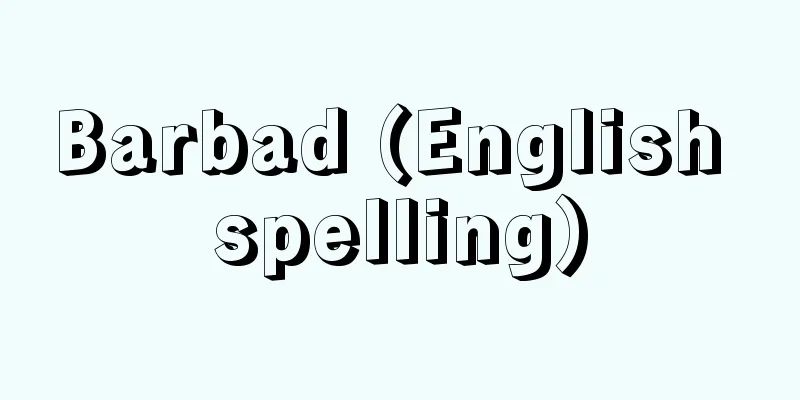Behaviorism

|
A methodology in modern psychology that originated from "The Behaviorist's View of Psychology" published by JB Watson in 1913. [Background of Behaviorism] There are several ideas that influenced the emergence of behaviorism. One is the functionalism of James, W., which analyzed the mind based on its functions, not its structure. He aimed to explain the mind physiologically, but maintained introspection (a method of observing one's own consciousness) as a research method, and Watson criticized functionalist psychology as not being scientific psychology either. The other is the trend in animal research, and Loeb, J. and Jennings, HS were at Johns Hopkins University at the same time as Watson, and Watson was taught by Loeb. Thorndike, EL, who constructed the first experiential reinforcement theory, and Yerkes, RM, who began researching apes, also seem to have contributed to behaviorism, but Watson did not appreciate Thorndike at all, and Yerkes was also critical of Watson. [Watson's Behaviorism] Watson believed that the goal of science was "prediction and control." He believed that behavior could be divided into external behavior and internal behavior that cannot be observed from the outside, and that thoughts could also be studied by analyzing minute muscle movements. Although his 1913 paper did not provide specific research methods, he later learned of Pavlov's theory of conditioned reflexes and used this as his main method. However, while Pavlov viewed conditioned reflexes as a method of studying the cerebrum, Watson had little interest in brain research. [The ideological background of behaviorism after Watson] Logical positivism and operationalism played a major role in the transition to post-Watson behaviorism. Operationalism states that "concepts are synonymous with a series of operations." This is called operational definition, and even something that cannot be directly perceived, such as intelligence, can be defined by operations, such as "a score measured on an intelligence test." Another major feature was the pointing out of category errors. For example, questions such as "When did time begin?" were considered nonsense. Logical positivism, a twin movement of thought to operationalism, claimed that problems could be treated in the same way by making them protocol propositions whose truth or falsity could be verified. In other words, any scientific problem can be treated in the same way if it can be reduced to a proposition of formal logic. From this, it advocated a unified science, in which all sciences are the same. Psychology, which was a second-class science, could also become a science according to this way of thinking. This school also rejected questions such as "What is the thing in itself?" as false questions. Furthermore, Ryle, G. and Wittgenstein, LJ, advocated philosophical behaviorism, which aims to study the mind through the analysis of everyday language rather than protocol analysis. [Behaviorism after Watson] Under the influence of logical positivism, Stevens, SS, developed methodological behaviorism. This is an extremely clear-cut form of behaviorism that distinguishes between private experience and the public world, with only the latter being the subject of scientific research. Hull, CL developed a system of axiomatic behaviorism as an axiomatic system based on the hypothetico-deductive method. He proposed that need reduction and the resulting reduction in drive are the mechanism of learning at the individual level. Habit strength ( S H R ) is a function of the number of reinforcements, and multiplying this by the drive (D) and incentive (K) gives the response potential ( S E R ), and further subtracting response inhibition (I) from this gives the effective response potential ( S E R ) . R ). Response inhibition here consists of inhibition due to the response itself (I R ) and conditioned inhibition ( S I R ). This system is not only beautiful as an axiomatic system, but it was also the first quantitative model of learning to appear in psychology. A major feature of EC Tolman's cognitive behaviorism is that, while using behavior as an indicator, he introduced cognition as an intermediary variable. He believed that learning was the understanding of the means-end relation, and clarified the difference between learning itself and externally expressed behavior in experiments on latent learning. His system gradually became complex and difficult for other researchers to understand, but the idea of spatial cognition in animals was later revived in hippocampus research. Skinner, BF, constructed a system of radical behaviorism called behavior analysis. Following Watson's work, this system was very fruitful, giving rise to fields of application such as behavior modification and behavioral pharmacology. Skinner devised various methods of giving reinforcement, called the schedule of reinforcement, for operant conditioning, and developed the Skinner box as an experimental device and a cumulative recorder as a behavior measuring device. He also showed that complex behaviors (such as making pigeons play table tennis) can be formed by successive approximation, which is a method of training simple behaviors little by little. This method of behavior shaping gave birth to a teaching method called programmed learning. He consistently took a position that emphasized description, and used a within subject design, in which experimental variables were changed in the same subjects. He did not accept the existence of the mind, but unlike Stevens, he studied personal experiences and analyzed linguistic behavior. This research method is close to Ryle and Wittgenstein. Skinner warned against easily seeking explanations for behavior in the nervous system, but this was based on the historical understanding at the time that it was better to conduct research independently, and he believed that psychology was originally a branch of biological science. However, Skinner's slogan "Don't talk about what's under the skin" made his followers rigidly averse to neuroscience, leading to the isolation of behavioral analysis. [The future of behaviorism] Skinner himself divided the contingencies that shape behavior into ontogenetic contingencies and phylogenetic contingencies, but few people studied the latter, and it did not get along well with ethology, which focuses on species differences. However, operant conditioning is an excellent method for studying animal behavior, and it eventually developed into comparative cognitive science and brain research. Behaviorist theory is ultimately a learning theory, and as psychologists' interests shifted away from learning, the role played by behaviorist psychology also diminished. → Reinforcement schedules → Behavior modification [Watanabe Shigeru] Latest Sources Psychology Encyclopedia Latest Psychology Encyclopedia About Information |
|
1913年にワトソンWatson,J.B.が発表した「行動主義者から見た心理学」から出発した現代心理学における方法論。 【行動主義の背景】 行動主義の発生に影響を与えたいくつかの考え方がある。一つはジェームズJames,W.の機能主義であり,心の構成ではなく,その機能に基づく分析を行なった。彼は心の生理学的説明をめざしたが,研究方法としての内観(自分で自分自身の意識を観察する方法)は維持しており,ワトソンは機能主義心理学もまた科学的心理学たりえないと批判している。もう一つは動物研究の流れであり,ロエブLoeb,J.とジェニングスJennings,H.S.はワトソンと同時期にジョンズ・ホプキンス大学におり,ワトソンはロエブの指導を受けた。最初の経験的強化理論を構築したソーンダイクThorndike,E.L.,類人猿の研究を始めたヤーキーズYerkes,R.M.も行動主義に寄与したように思えるが,ワトソンはソーンダイクをまったく評価していなかったし,ヤーキーズもまたワトソンに批判的だった。 【ワトソンの行動主義】 ワトソンは科学の目的を「予測と制御」であるとした。行動は外的行動と外からは観察されない内的行動に分けられ,思考なども微小な筋肉運動などの分析で研究できるとした。1913年の論文では具体的な研究方法は示されなかったが,のちにパブロフPavlov,I.P.の条件反射conditioned reflexの理論を知り,それを主たる方法とした。ただパブロフが大脳の研究法として条件反射をとらえていたのに対し,ワトソンは脳研究への関心は薄かったといえる。 【ワトソン以降の行動主義の思想的背景】 ポスト・ワトソンの行動主義への移行には,論理実証主義logical positivismと操作主義operationismが大きな役割を果たしている。操作主義では「概念は一連の操作と同義語」であるとされた。これが操作的定義といわれるもので,知能のように直接知覚できないようなものでも「知能テストで計られたスコア」のように操作によって定義できるとした。もう一つの大きな特徴はカテゴリーエラーの指摘であった。たとえば「時間はいつ始まったのか」といった設問はノンセンスであるとした。操作主義と双子のような思想運動が論理実証主義で,問題を真偽の検証可能なプロトコル命題にすることにより同じように扱えるとした。つまり,どのような科学の問題も形式論理の命題に落とし込めれば,同じように扱える。そこから,すべての科学は同じという統一科学unified scienceを主張した。二級科学であった心理学も,この考え方によれば科学たりえたのである。この学派も「物自体とは何か」といった設問は偽問題として退けた。さらにライルRyle,G.やウィトゲンシュタインWittgenstein,L.J.は,プロトコル分析ではなく日常言語の分析で心の研究をめざす哲学的行動主義philosophical behaviorismを提唱していった。 【ワトソン以降の行動主義】 論理実証主義の影響下にスティーブンスStevens,S.S.は方法論的行動主義methodological behaviorismを構築した。これはきわめて明快な行動主義で,私的経験と公的世界を区分し,後者のみが科学研究の対象であるとした。ハルHull,C.L.は仮説演繹法に基づく公理系としての公理論的行動主義axiomatic behaviorismの体系を構築した。要求低減need reductionとそこから派生する動因driveの低減が,個体レベルでの学習の機構であるとした。習慣強度(SHR)は強化数の関数であり,これに動因(D)と誘因(K)を乗じたものが反応ポテンシャル(SER),さらにそこから反応抑制(I)を減じたものが有効反応ポテンシャル(SR)になる。ここでの反応抑制は,反応そのものによる抑制(IR)と条件性抑制(SIR)からなる。この体系は公理系として美しいばかりでなく,心理学に登場した初めての学習の数量モデルであった。トールマンTolman,E.C.の認知的行動主義cognitive behaviorismでは,行動を指標として用いつつも仲介変数としての認知を導入したことに大きな特徴がある。学習は目的-手段関係means-end relationの理解であるとし,潜在学習latent learningの実験で学習そのものと外に現われた行動の違いを明らかにした。彼の体系はしだいに複雑なものになり,他の研究者が理解しづらいものになっていったが,動物の空間認知という考え方は後に海馬研究において復活した。 スキナーSkinner,B.F.は,行動分析behavior analysisといわれる過激行動主義radical behaviorismの体系を構築した。ワトソン以降の流れの中では行動修正behavioral modification,行動薬理behavioral pharmacologyなどの応用分野を生み出した実り多い体系であった。スキナーはオペラント条件づけの方法に強化スケジュールschedule of reinforcementといわれるさまざまな強化の与え方を考案し,実験装置としてスキナー箱Skinner box,行動測定器としての累積記録器を開発した。また,複雑な行動(たとえばハトに卓球をさせる)も単純な行動から少しずつ訓練していく逐次的接近法successive approximationによって形成されることを示した。この行動形成shapingという手法は,プログラム学習という教授法を生み出した。彼は一貫して記述を重視した立場を取り,同じ被験体で実験変数を変化させる被験体内計画法within subject designを用いた。彼は心の存在を認めない立場を取るが,スティーブンスと異なり私的経験を研究対象とし,言語行動の分析を行なった。この研究法はライルやウィトゲンシュタインに近い。行動の説明を安易に神経系に求めることを戒めたが,これは当時としてはそれぞれ独立に研究を進めた方がよいという歴史認識に基づくもので,心理学は本来生物科学の一分野であると考えていた。しかし,「皮膚の下の話をするな」という標語はスキナーの追随者たちを硬直した神経科学嫌いにし,行動分析の孤立化を招いた。 【行動主義のその後】 スキナー自身は,行動を形成する随伴性を個体発生的随伴性ontogenetic contingencyと系統発生的随伴性phylogenetic contingencyに分けたが,後者の研究をする者は少なく,種差を問題とする動物行動学とは折り合いが悪かった。しかし,オペラント条件づけは動物行動の研究法としては優れた手法であり,やがて比較認知科学や脳研究へと発展していった。行動主義の理論は結局学習理論であり,心理学者の関心が学習以外に向かうと行動主義心理学の果たす役割もまた少なくなっていった。 →強化スケジュール →行動修正 〔渡辺 茂〕 出典 最新 心理学事典最新 心理学事典について 情報 |
<<: Girls' high school - koutoujogakko
Recommend
Louis VII
1120-80 The sixth Capetian king of France. Reigned...
Riemannian manifold
Since a differentiable manifold can be considered ...
Megaderma spasma (English spelling)
…[Yoshiyuki Mizuko]. . . *Some of the terminology...
Yeon Gaesomun
A statesman from the end of the Goguryeo Dynasty ...
Hōgen Shinsei
The new system of court nobles was issued by Emper...
Vernadskii, IV (English spelling)
...For this reason, their opponents, the Slavophi...
Antonie van Dyck
1599‐1641 Flemish painter. Also spelled Van Dyck. ...
Meier, GF (English spelling) MeierGF
...This group is made up of disciples who inherit...
Viceroy of India
…the highest governing official position in the f...
North Slope
An oil field area in the northern part of Alaska, ...
Stretching and heat treatment machine
…(1) Chemical fiber machinery In the past, this m...
Ameya Yokocho - Ameya Yokocho
...The Ueno area, which is centered around Ueno S...
California Cultural Region
...Representative tribes include the Nootka, Haid...
Gozenyado - Omonoyado
…The west wing is the same size as the east wing,...
lugal
Some scholars point out the existence of the Suba...
![Tsugawa [town] - Tsugawa](/upload/images/67cc3aeea640d.webp)








